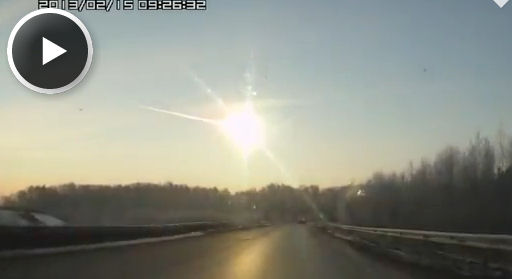Hang the Transit of Venus on your wall! Hubble-quality images from NASA's Solar Dynamics Observatory are now available as metallic posters in the Space Weather Store. | | |
RUSSIAN METEOR UPDATE: On Friday, February 15th at 9:30 am local time in Russia, a small asteroid struck the atmosphere over the city of Chelyabinsk and exploded. According to reports from news organizations and Russian authorities, as many as 1000 people received minor injuries from the shock wave. This is the most energetic recorded meteor strike since the Tunguska impact of 1908.
Researchers including Prof. Peter Brown of the University of Western Ontario along with NASA experts have conducted a preliminary analysis of the event. "Here is what we know so far," says Bill Cooke, head of NASA's Meteoroid Environment Office. "The asteroid was about 15 meters in diameter and weighed approximately 7000 metric tons. It struck Earth's atmosphere at 40,000 mph (18 km/s) and broke apart about 12 to 15 miles (20 to 25 km) above Earth's surface. The energy of the resulting explosion was in the vicinity of 300 kilotons of TNT." (continued below)

"A shock wave propagated down and struck the city below, causing large numbers of windows to break, some walls to collapse, and minor damage throughout the city," he continued. "When you hear about injuries, those are undoubtedly due to the effects of the shock wave, not due to fragments striking the ground. There are undoubtedly fragments on the ground, but as of this time we know of no recovered fragments that we can verify."
Videos of the event may be found here and here. In many of the videos you can hear the sound of windows shattering as the meteor's loud shock wave reaches the ground. Onlookers cry out in Russian as alarms and sirens sound in the background. This pair of wide-angle gif animations is also worth watching: #1, #2.
It is natural to wonder if this event has any connection to today's record-setting flyby of asteroid 2012 DA14. Paul Chodas of the Near Earth Object Program at JPL says no. "The Russian fireball is not related to 2012 DA14 in any way. It's an incredible coincidence that we have had these two rare events in one day."
Stay tuned for updates!
GOOD-BYE 2012 DA14: Asteroid 2012 DA14 few past Earth on Feb. 15th inside the orbit of many geosynchronous satellites. At closest approach, around 2:25 pm EST, the 45-meter wide space rock was only 17,200 miles above Indonesia. No satellites were damaged by the flyby, and the asteroid is now receding from Earth.
Using a 3" refractor at the Siding Spring Observatory in Australia, Aaron Kingery captured this image of 2012 DA14 passing in front of the eta Carina Nebula:

NASA's Goldstone radar in the Mojave Desert will ping the space rock for the next four days to refine its orbit and map its surface features. Researchers will look carefully for signs that Earth's gravity might have caused seismic activity on the asteroid.
Browse the realtime gallery for more images from around the world.
Realtime Space Weather Photo Gallery
VALENTINE'S DAY MAGNETIC STORM: Valentine's Day in Scandinavia began with a magnetic storm. Rob Stammes of the Polar Light Center in Lofoten, Norway, reports: "Our instruments recorded 2o swings in the local magnetic field, which induced strong electrical currents in the ground outside our lab." The needles on his chart recorder were swinging wildly:

"Overhead we saw some fantastic auroras," he adds.
The storm was caused by a region of south-pointing magnetism in the solar wind that wafted past Earth during the early hours of Feb. 14th. The solar wind's south-pointing magnetic field partially canceled Earth's north-pointing magnetic field, opening a crack in our planet's magnetosphere. Solar wind poured in to fuel the storm.
Browse the realtime gallery for images of some sweet auroras on Valentine's day. Aurora alerts: text, voice.
Realtime Aurora Photo Gallery
Realtime Comet Photo Gallery
Realtime Noctilucent Cloud Photo Gallery
[previous years: 2003, 2004, 2005, 2006, 2007, 2008, 2009, 2011]

